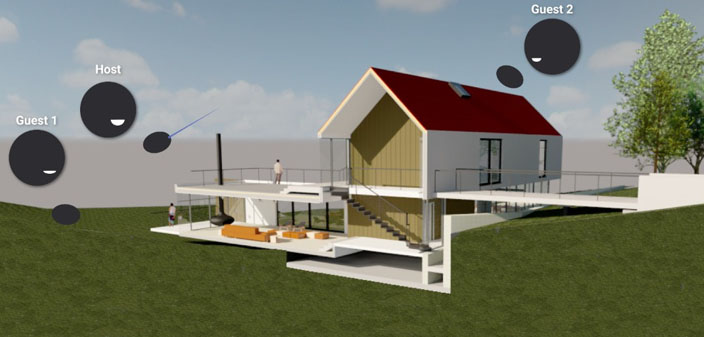One of the significant barriers to the adoption of virtual reality (VR) by small to medium architecture and construction firms has been the software learning curve. That’s about to change – thanks to SENTIO VR.
The recently launched distribution channel from Facebook’s Oculus, App Lab, has a new app for Oculus Quest 2 that architects will appreciate. Introduced by SENTIO VR, the official app makes it even simpler for Architecture, Engineering & Construction (AEC) professionals to integrate VR into their design review & client presentation workflows for SketchUp models, Revit BIM models, and additional 3D content.
This was only made possible through the recent creation, by Facebook, of the new official distribution channel from Oculus, App Lab, which made the whole loading process a single step, where you can just search for the app inside VR or use the App Lab installation link. Prior to this, the only way to install the app in Quest was via sideloading manually – a multi-step process that required creating a developer account and was tedious to use.
The situation was made worse because of another reason: typically, firms use multiple Oculus Quest headsets for internal design reviews. This means installing the software on each of the headsets – which can be cumbersome if development or technical processes are required. Now, each user can install the app without any technical expertise making company-wide VR adoption simpler.
SENTIO VR co-founder & CEO Chaitanya Ravi sees this as a huge enabler for VR adoption in AEC. “With a high-quality standalone VR headset like Quest 2 at an affordable price point, easy-to-use software that integrates with design workflows, the barrier to entry to engage clients early and avoid communication errors in the design process using VR for SMBs has been reduced drastically.”
Intuitive software for SMBs
A major barrier to the adoption of Virtual Reality in Small & Medium Architecture & Construction businesses has been the lack of easy-to-use software that integrates with design workflow. With the App Lab version being compatible with the consumer version of Quest 2 priced at $299, a wireless and affordable solution is available for everyone. According to Chaitanya Ravi, “if you require to implement VR for your teams and projects at a non-enterprise scale, this works out as a perfect option from a cost & implementation perspective.”
The easiest way to transport your clients inside your Sketchup models so that they can understand your designs well is through VR, and there the SketchUp and Autodesk Revit plugins help, as users lose no time in uploading models to the cloud & getting into VR meetings using access codes.
Ken Mahood, Principal Architect at JH Architects, a client shares his experience:
“SENTIO VR is a transformative software product that not only blows the minds of our clients when we show them their project but also surprises us as the designers. The Revit add-in interface is extremely easy to use and the price reasonable. I highly recommend this product to any Architect.”
Multi-user VR collaboration
Since a lot of the design review meetings include external stakeholders, especially clients – it is essential to make it as easy as possible for clients to get the software in the first place. Over the last year, VR meetings have become a powerful option to review designs internally and with clients remotely. Any client can now receive an Oculus Quest 2 headset – install the App Lab version of SENTIO VR and join meetings or walkthrough their designs using an access code – making it extremely simple for remote collaboration in VR to work seamlessly. With a simple 6-digit code and password, up to 5 users can join intuitive VR meetings using the Quest App, strengthening remote collaboration and increasing productivity.
To learn more, visit the company’s website or write to [email protected].






